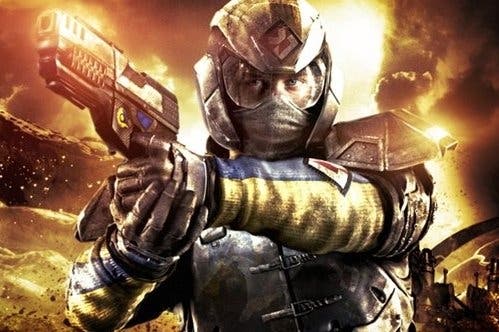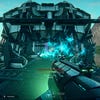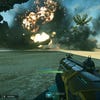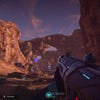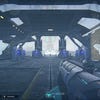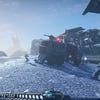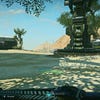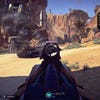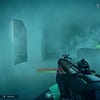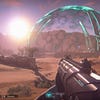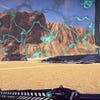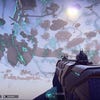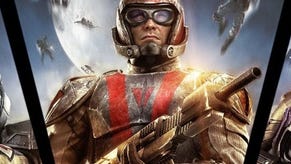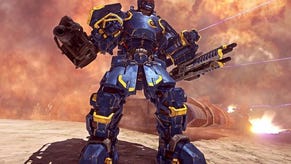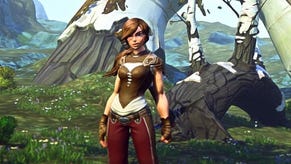Digital Foundry: Hands-on with PlanetSide 2 on PS4
From the archive: Daybreak Game Company's MMO shooter makes its console debut.
We originally published this article on the PlayStation 4 PlanetSide 2 beta on April 26th, and were all set to produce a new piece for the game's launch. However, once the EU servers came online, we found that our thoughts on the game - along with its overall performance profile - remain largely unchanged. That being the case, we're re-publishing our original piece for those that may have missed it originally.
Just how many players is too many for a console first-person shooter? After three years of sole residency on PC, PlanetSide 2 asks that very question as the PlayStation 4 beta rages on this month. It's an affair that has thousands of players vie for supremacy on a single server at once - an unprecedented figure for any console game. But given PS4's struggle to hold 60fps even in 64-player titles like Battlefield Hardline, how has this been made possible? And indeed, is everything intact in the transition from PC to console?
First up, the basics. From a technical perspective, developer Daybreak Game Company (previously Sony Online Entertainment) is targeting a native 1920x1080 framebuffer and a capped 30fps update for the final PS4 release. An initial look at the beta right now confirms this full HD presentation is in effect, giving us the sharpest base image we could hope for. However, it uses a similar post-process AA method to the PC version; an effect that blurs over its artwork to a degree, while sub-pixel coverage is at times spotty on fine details. Even PC struggles in this area, with no alternative methods offered directly via its display menu - meaning overall image quality is extremely close between the two in practice.
It's a solid start for the console rendition, but PlanetSide 2's scale is the real selling point. Powered by the Forgelight engine, the PS4 version boasts a huge online landscape that supports thousands of players in a continuous, large-scale conflict. Content-wise, the beta opens up all four of PlanetSide 2's continents for players to explore, in addition to providing an extra fifth designed to ease newcomers into the initially daunting online experience. PC-grade environmental quality is upheld across each of these, with players able to explore the terrain via different aircraft, tanks, and upgrades such as jet packs that add a real sense of verticality to battles.
In an earlier interview with the team's creative director Matt Higby, he revealed that the goal of the PS4 version is simple: achieving parity with the PC's ultra graphics settings while updating the user interface to better suit a console title. The visual return is very close in practise, as shown by our zoomer gallery below. For comparison, our PC set-up has every graphics preset at its highest point, with 100 per cent render quality, ultra grade textures, shadows and particles, and all other settings peaking at the high setting.
PS4 delivers a comparable level of visual quality. Planetside 2's colossal maps are rendered with similar texture resolution to the PC's ultra preset, with geometry also of equivalent complexity based on our shots. The console version's draw distances hold up, too; a faint fogging effect hovers on the far horizon, while PC delivers just a touch more detail in the distance with less pop-in, though the difference is subtle. The use of lower-resolution textures on energy beams stands out on PS4 in some instances, but these are few and far between. On the whole, we get a real sense that the top-end graphical presentation on PC is translated as-is to PS4, even down to the use higher quality anisotropic filtering.
The PC's best lighting tricks and effects are in place too. This includes a time of day system that shows of the engine's dynamic lighting, and simulates the effects of global illumination across the environment. Blending ambient and direct light sources, this allows for atmospheric simulation that lets sunlight react with particles in the air to produce a haze distortion effect, plus bloom. The decision to aim for this realistic look has drawbacks though, with certain times in the day-night cycle robbing environments of depth and muting some texture details. Shadows also only update every couple of seconds (rather than on every frame in a seamless fashion), causing shade to jut across the environment in jarring steps. It's a quirk of the PC release, and one that has a bearing on the PS4's look too.
Though the environments are clearly a talking point in PlanetSide 2, combat takes centre stage. Players are split across three factions working to take control of the map, region by region - the gunplay ranging from frenetic close-quarters shootouts to prolonged battles between aircraft and ground vehicles. Tying this together, PhysX middleware is used to create temporary bullet holes on walls and other surfaces when shot, while thick plumes of smoke deliver cover for squads flanking the opposition. With a mixture of particles and explosions that cast light across the world, the effects work here is fairly solid - though the lack of motion blur reduces the intensity of fast-moving scenes, while alpha-based flame effects often appear simplistic.
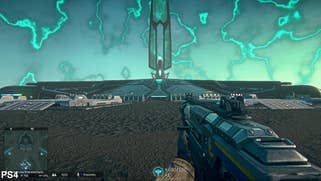
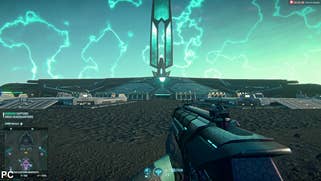

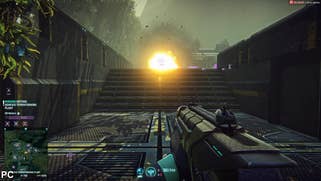


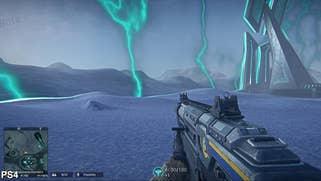
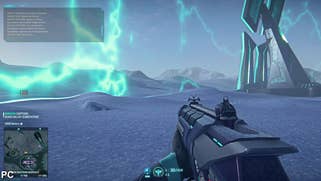

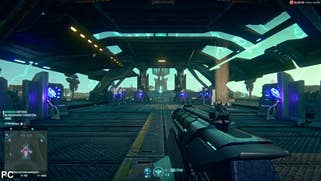
All told, Daybreak Game Company does an excellent job of bringing the PC game to PS4 without any hugely noticeable visual cut-backs. General assets and effects are broadly identical, right down to how surface shaders are handled under different lighting conditions. However, the scale of the action is a big part of what PlanetSide 2 brings to the table, and it's here that we see a difference in the PS4's ability to handle masses of players on-screen at once. With a frank admission that PS4 is CPU-bound when it comes to tracking thousands of players per map, there is an evident limit to its level of performance in all scenarios.
The studio has a 30fps cap in mind for the final PS4 release, but right now the beta runs at an uncapped frame-rate with no v-sync engaged. This approach benefits the gameplay of an online FPS by ensuring we receive the fastest controller response possible when the engine is under load. Frames are displayed in time for the next screen refresh even if they are incomplete, thus resulting in heavy tearing, but on the flip side frame-time is more consistent, leading to less jarring differences in response times from one frame to the next.
While we've yet to experience the beta at maximum capacity on PS4, our busiest game tops out at 45 per cent on the European server, which still gives a good sense of overall performance. Exploring the rocky landscape on Indar, PlanetSide 2 operates at a perceptual 60fps on console where moving and aiming is fluid, though the constant tearing across the screen does distract. In small battles, we find frame-rates operate between 45-60fps, delivering a level of smoothness that looks and feels a step above that of a game running at a variable 30fps. However, the refresh still comes across as uneven due to the game's excessive screen-tear.
However, moving into more intense combat situations, we see frame-rates that frequently go south of 30fps. Leaping across several rooftops to join a small skirmish in a nearby outbuilding, the range is often between 27-30fps, resulting in heavy judder and weighty controls that makes aiming less precise. The ebb and flow of the action comes across as jerky and distinctly uneven, with tearing artefacts only accentuating the loss in smoothness caused by the variable refresh. Even in fairly small, concentrated skirmishes between half a dozen players, performance is prone to drop down to the mid-twenties. The scale of battle here is limited of course, and at launch there's the potential for the engine to be much more heavily taxed in conflicts featuring hundreds of players. However, it's clear why the studio is backing away from its originally intended 60fps target for the game, in favour of a half-refresh.
The regularity at which frame-rates drops below 30fps is a concern too, and at its current level of optimisation such a 30fps cap will struggle to disguise the lowest readings on our graph. Fortunately shootouts in other spots fare a little better, and frame-rates hover anywhere from 30-45fps during a string of smaller fire-fights across Indar. In these scenes the appearance of multiple vehicles, illuminated projectile effects and volumetric smoke has the engine struggling. Judder is still noticeable and controller response remains an issue - but on the plus side, the action holds up better overall when compared to the worst, sub-30fps sections.
Ultimately there's a chasm between scenes operating near 60fps and those closer to (and below) 30fps in Planetside 2. At higher fame-rates, the uncapped refresh works well from a gameplay perspective; controls are more stable despite the heavy tearing, but the situation just isn't satisfactory when the engine is under load. In this case, an adaptive 30fps makes sense for the final product, to give players more consistency. With this in place, we can expect a less noticeable switch in performance between PlanetSide 2's barren landscapes and its tightly knit, hectic stretches of combat.
So far, PlanetSide 2 offers up a multiplayer shooting experience unlike any other on PS4, with a world large enough to accommodate hundreds of players in one persistent battleground. From a visual perspective the hardware is used well too. The PS4 beta closely matches the PC release; its lighting model is upheld, environments are detailed to the same standard, and combat makes use of matching projectile and volumetric effects. As far as playability goes, we've yet to see PlanetSide 2's servers populated enough to see the full extent of its mayhem - an issue hard to avoid with the limited nature of the beta. There are also a number of bugs that need addressing at present, such as players dying immediately at a spawn point and issues with corrupt character slots. Come release, the state of the PS4 version's quality will become much clearer.
On a more positive note, the experience translates well to the DualShock 4 controller when compared to the PC's mouse and keyboard. There's a lot to learn in Planetside 2, but the process of choosing spawn locations, changing load-outs, and generally navigating the console UI is easily handled by tapping the shoulder buttons. The front-end is often less busy than the PC's too, though the console menus are slow to respond in its current state - something we hope is also improved by launch.
Overall, while there are still bugs that need eliminating, at this stage our main sticking point with the PS4 version of Planetside 2 is performance. The level of tearing is at times unsightly, while its variable frame-rates result in an experience that lacks consistency, jumping from near 60fps in desolate areas to below 30fps during combat. Daybreak Game Company is targeting a 30fps cap, and hopefully we'll see a more balanced approach to managing its screen tearing. If these performance and stability issues are addressed, there's definitely potential for Planetside 2 to deliver a fresh take on the online shooting scene occupied by the likes of Destiny and Battlefield.
